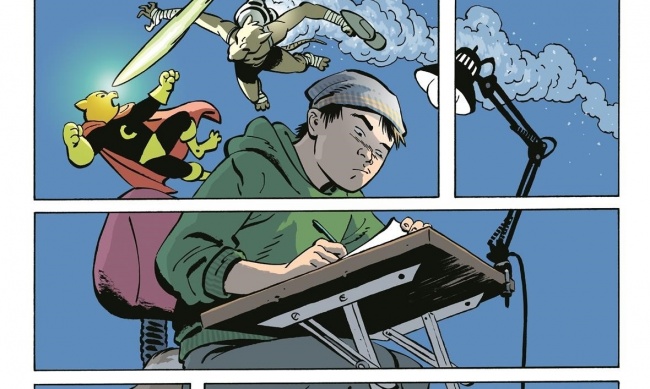Ethan Young spoke with the kind of self-effacing humor that makes everyone feel more comfortable with themselves. It helped diffuse those first few awkward minutes of the convention panel. I first saw Young at New York Comic Con almost a year ago now. He struck me as someone acutely self aware, no small task in an industry that often rewards and thrives on hubris. Young is not afraid to be self-critical and analytical of his past behaviors.
During the panel, Young discussed his process for researching and writing his award-winning book, Nanjing: The Burning City. He reflected on the history of China, his parents and his own personal history. He talked of all he didn’t know and what he has yet to learn. He reflected on the tangled web of familial history as it mingled with and became distorted by the larger history of a country, of countries: China and the United States. Young’s personal story is the focus of the recently published semiautobiographical book, Life between Panels: The Complete Tails Omnibus (Dark Horse). It’s a beautifully considered collection of his webcomic Tails which Young began syndicating online in 2009.
Tails is the story of Ethan’s life as a young, struggling cartoonist living in New York City along with his coterie of cats. As the series progresses we learn more about Ethan, his love life and his quest to bring his comic series ‘Crusader Cat!’ to life. It isn’t long before Ethan finds himself immersed in his own fiction, unable to distinguish between real life and fantasy.
I spent several weekends reading Life between Panels. I knew I wanted to reach out to him to talk about the omnibus, creating and what it’s been like to expose a personal journey in public. Young lays himself pretty bare in the book. It was the kind of honesty I tend to save for my pillow before bed. Those moments before sleep hits where I acknowledge my great mistakes and regrets. In Life between Panels, Young confesses them, he wrestles with them for all of to see. He does not, however, defeat them. It’s a courageous choice, a choice I was grateful for as someone grappling with the legacy of family, boundaries, and those seemingly incidental decisions that shape the contours of our lives.
The foreword of Life between Panels is written as part reflection, part explanation. A reflection on the person he was when he wrote Tails and the person he is today. Then, an explanation for why he didn’t change or update the comic. It stands, as a testament to the journey he was on as a creator, artist, and person. As the foreword inspired many of the questions for our interview, I have included it below with Young’s permission.
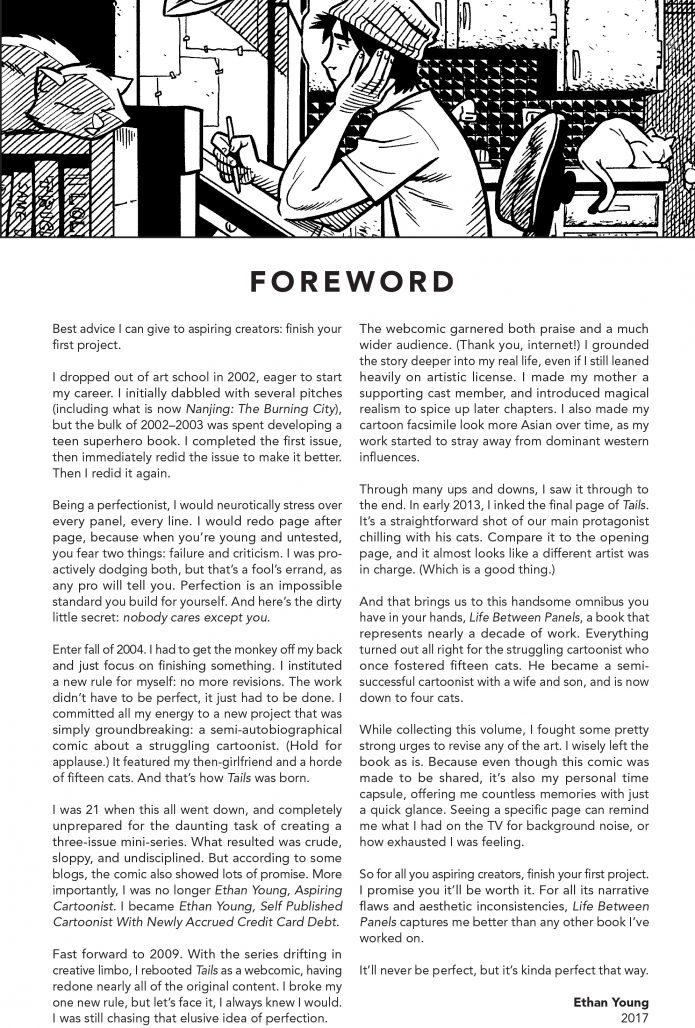
***
AYRES: I wanted to touch on how valuable the advice you give in the foreword is. You say, ‘finish your first project’ and damn if that isn’t the truth. I think it’s easy for us to look at the work being done around us and get caught up in idealized versions of what a project must be. Do you have advice for people out there who get frustrated with the process? When their ideas don’t manifest in the way we see them in our heads, when it’s not perfect? How did you abide by the no revisions rule? I can scarcely write a sentence without revising!
YOUNG: I’ve learned to push back all the initial anxiety that comes with being a perfectionist. The anxiety is always there; the constant self-questioning and Imposter Syndrome creeping up. Learn to focus on the finish line. Remind yourself, “Nobody is going to judge my work based on one panel. They’ll judge my work based on a whole body of work.” Understand that any mistakes you make on the page are best remedied in the next book, and not with constant revisions.
That kinda ties into my larger piece of advice for beginners: your first book won’t be your magnum opus. It might seem like others are receiving instant success at a young age, but those are so statistically rare that they feel amplified (like plane crashes). Finish your first book, then finish another. Keep learning, keep growing. Don’t get too hyped by praise and don’t get too discouraged by critique. The true assessment of your work is somewhere in the middle.
Take it one line at a time, and before you know it, you’ll have a living, breathing product.
AYRES: How was it revisiting all of this material? You are really uncompromising in the depiction of the main character (aka you or at least a version of you anyway). I know you had mentioned that you took some artistic license but was it (and is it) hard to look back on these different versions of yourself?
YOUNG: I don’t cringe as much as I used to when I look back on old depictions of myself. I’ve been able to step away and gain clarity on my younger self; how I viewed the world and how I processed it, for better or worse. More than anything, I feel a wave of relief when I flip through Life Between Panels. It’s really bittersweet, like a great high school memory.
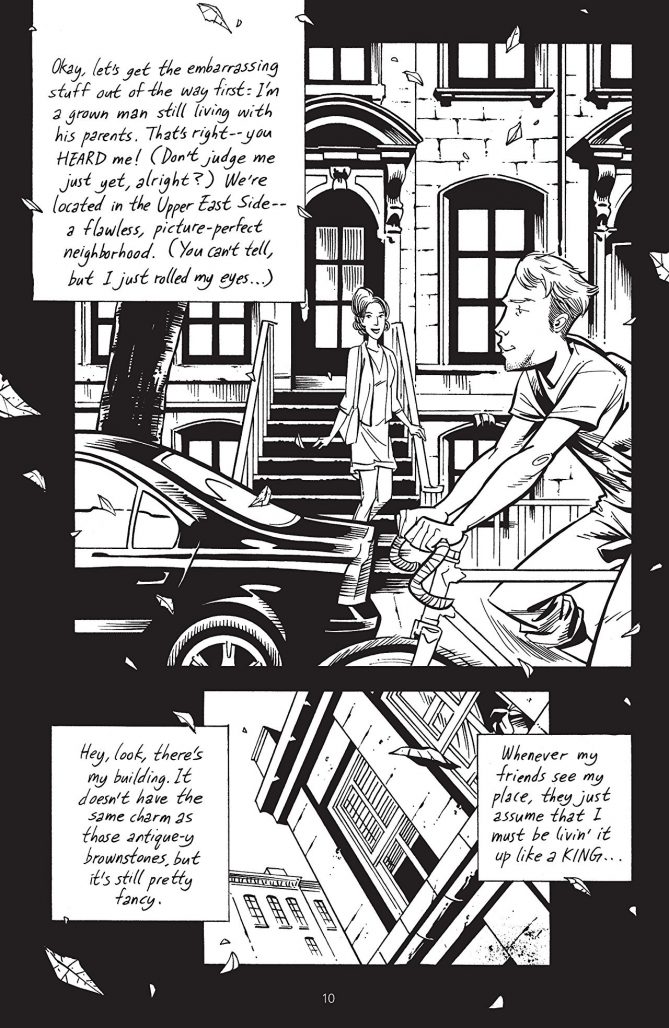
AYRES: This character reminds me so much of myself in my 20s. I was painfully introverted with an over-sized ego, extreme perfectionist tendencies, lonely as hell, and nowhere to funnel creative energy. I think a lot of people feel this way, I’m wondering if you can speak to any of that? Perhaps contrasting how you engaged with your loneliness, perfectionism back then versus how do you engage with it now?
YOUNG: It’s strange, because my outsized ego never went away. It only got larger, but so did my insecurity. In the past, my biggest fear was failure. After Nanjing, and winning the Reuben Award, my biggest fear is that I’ll just be a One Hit Wonder. I think Imposter Syndrome never goes away, you just learn to manage it, like the Babadook.
I’m still a fairly isolated creator. I tried socializing with a local comic gathering for a while, but it didn’t work out for me. I’m so stubborn that whenever someone would offer innocuous advice, I would immediately get defensive. I’m not built for collaboration, I guess.
The one thing that’s different, like I said, is managing that. I try not to allow my arrogance to ruin interpersonal relationships anymore. I force myself to relax from time to time. I still see everything as a competition, but I’ve learned to keep that to myself. And luckily, with a small amount of success, you can let your work speak for itself.
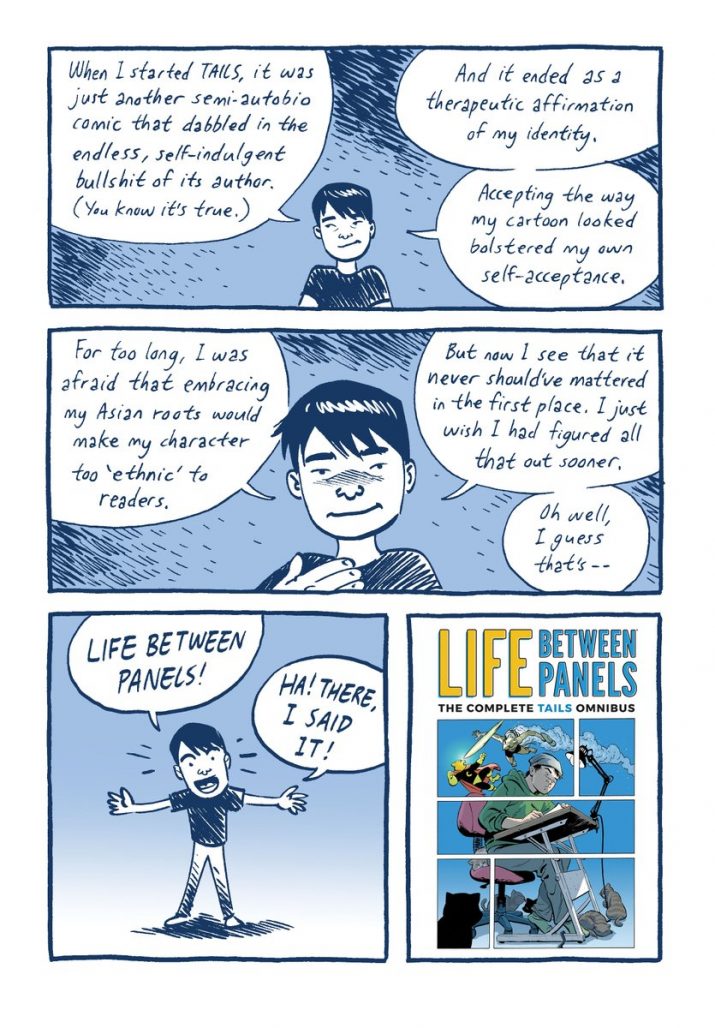
AYRES: In the foreword you had mentioned how the comic changes as you relied less on Western influences. I don’t think that’s something people, especially Western readers, contend with enough. How the cultural influence of Western society impacts, in seen and unseen ways, how and what they read. Can you describe if those changes were intentional, was it something you had always been aware of? I’d just be really interested in knowing more about that process if possible. What’s something you wish more Western readers were aware of?
YOUNG: I think many (not all) Western readers need to work on their cultural blindspots. In the beginning of Tails, the Asian American identity of Ethan is virtually unseen. I aimed to make Tails a color-blind comic at first, and I really regret that now.
Back when I was running the webcomic, I asked readers if they picked up on Ethan being Asian American. Some did, some didn’t. One reader felt that Ethan read as universal, so he could be anyone, any race. That drew another reader’s adamant retort. “Ethan clearly is not black or brown, so how is that universal?” So that really, really stuck with me. So much of what we identify as universal is just code for ‘passes as white’.
So as time went on, I aimed to change that and fully embrace the character’s identity, at least in the way he looked.
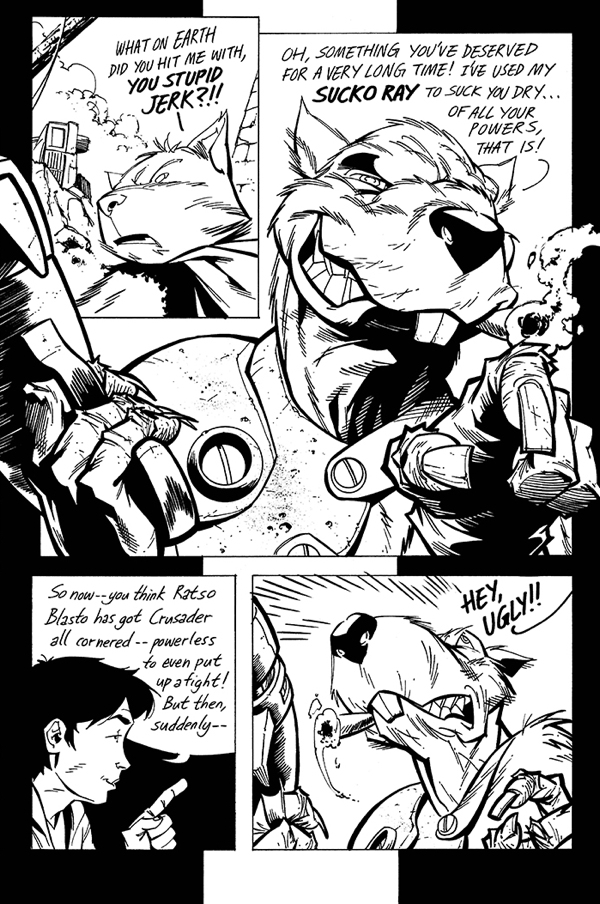
AYRES: (Attempting to not include any spoilers here) As the saga with Crusader Cat unfolds we see the storylines of Crusader Cat and the main character intertwine as his reality blends with fiction. It’s a useful way for the audience to learn more about the main character’s emotional landscape, what they were/are afraid of and perhaps become more enlightened about their past and how it’s influencing their current reality and relationships…
Do you think it was easier to insert Crusader Cat to talk about some of the more difficult parts? Because it is another step removed from you or the main character, did that have any influence in your ability to engage with the past or difficult subjects? I guess what I’m asking here is, was that a calculation you made or did it happen naturally? I’d love to know more about the insertion of magical realism.
YOUNG: That’s a great question. The middle of the book deals with childhood abuse. I purposely introduced it after readers have had some time to love/hate Ethan. But doing those fifty pages about my father resulted in a very tough period in my life, because it forced me to revisit a lot of stuff I had ignored for so many years. So as time went on, and the larger themes in Tails started to take shape, the connection between Ethan and Crusader Cat presented itself as a perfect metaphorical vehicle.
AYRES: In Life Between Panels there is a constant tension, sometimes spoken, sometimes unspoken and unseen, between the present, past and future. That tension is artfully sustained throughout the piece. How did you balance how much information to give the reader?
YOUNG: A lot of the book is created in-the-moment. I was personally working out that tension in my real life, so it naturally seeps into the page. With my family, there’s always going to be this incredibly complicated dynamic. I think allowing my storytelling to subtly hint at trama reflects what we all go through. It’s just like life, right? You see your family once or twice a year, and everyone tries to pretend like nothing bad has ever happened. Ever.
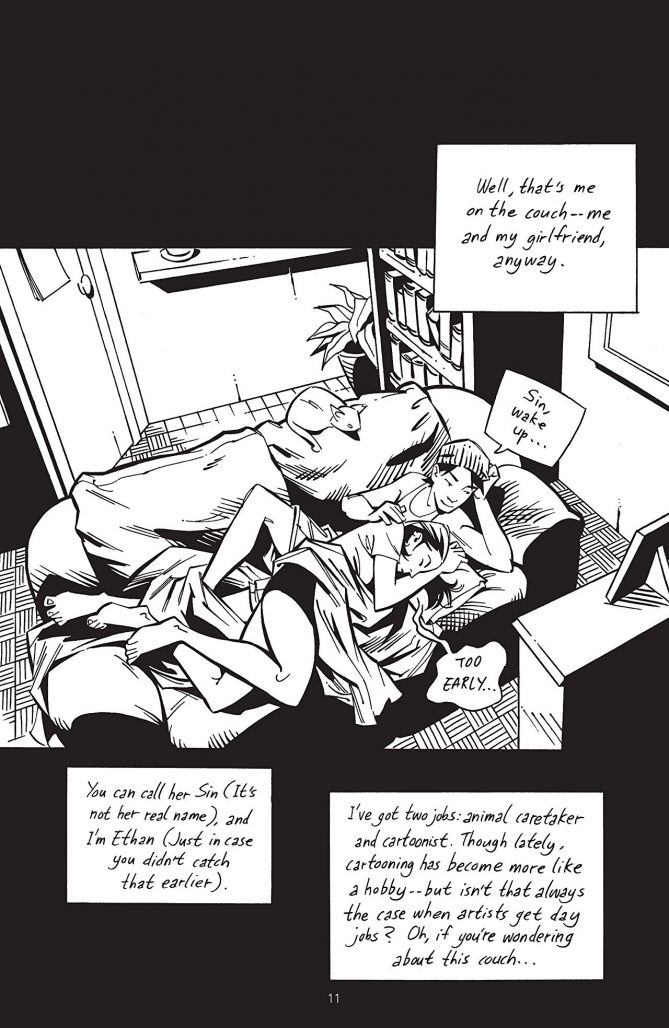
AYRES: I think there is a conception that when we read autobiography or semiautobiographical accounts, readers expect the material to be true. But truth is subjective, in so far as my experience with an event of my past would different from that of my twin’s of the same event. I’d honestly be curious to know how you view autobiography, what’s something you might want people to know about writing or engaging with material that is autobiographical in nature? For those of us who may want to write or draw our own autobiography, what advice might you give?
YOUNG: Be honest, be fair, but be passionate. Because let’s face it, nobody wants to read a boring autobiography, either. Someone wrote that all autobiography is fiction, since we are always the hero in our own story. But when you’re creating it in-the-moment, you’re clearly very biased. I’d suggest that you write something down, get all that rage and anxiety and passion onto the page, and then step away to let it digest a bit. Return to it and see if it still rings true a month later.
I started Tails when I was 21, and the original mini-series is basically just a neurotic journal comic about love and cats. When the webcomic launched, I was 26, and I mainly wrote about my problems as a 26 year old. But when I ended Tails, I was in my 30s writing about being 26, so I was fortunate enough to gain some introspection and humility along the way. I realized how the character was coming off, so I worked around that.
“Okay, Ethan is a lovable jerk, so how do we give closure that doesn’t necessarily let him off the hook?”
AYRES: Life between Panels ends rather simply, serenely. We aren’t granted a nice, neat solution to the character’s problems. We aren’t told how relationships are (or are not) resolved. Just wanted to know if you can talk more about the ending, how do people engage with it? Do they want to know how certain relationships evolved and what is that experience like for you? Do you have to draw boundaries for people, how do you engage with fans or readers in a way that still allows yourself privacy?
YOUNG: I’m very lucky that everyone pretty much views the story as a relic now. When the webcomic was still in weekly release, readers would occasionally pry a little here or there, but nothing too invasive. A few readers reached out and were very thankful that a comic that exposes so much vulnerability existed, and I’m forever grateful for that.
Overall, whether I’m talking about Life Between Panels or another project, I try to be as honest as humanly possible, so I’m pretty much an open book once you get to know me. Or ply me with beer.
***
So, what’s next for Young? Well, he’s not slowing down that’s for sure. The Battles of Bridget Lee Volume 2: The Miracle Child TPB goes on sale May 9, 2018 by Dark Horse. He is also continuing work on The Battles of Bridget Lee Volume III and a yet to be announced title. Oh, and making sure that his son is happy and healthy of course!
Life between Panels: The Complete Tails Omnibus
Author: Ethan Young
Paperback: 384 pages
Publisher: Dark Horse Books (April 17, 2018)
Language: English
ISBN-10: 1506704743
Note: Portions of this interview have been edited for clarity and conciseness.


